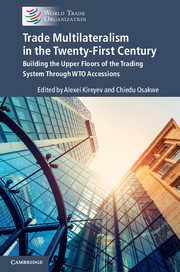 Trade Multilateralism in the Twenty-First Century
Trade Multilateralism in the Twenty-First Century from PART III - Accessions Acquis: Thematic Perspectives and Implementation Challenges
Published online by Cambridge University Press: 28 November 2017
Abstract
Important synergies and complementarities exist between trade liberalization initiatives and the application of measures to suppress anti-competitive practices or arrangements. Both anti-competitive practices of firms and state-orchestrated arrangements that restrict competition can undermine the gains from trade in myriad ways. Moreover, trade liberalization can be a powerful tool for addressing competition policy concerns. Whether there is a need to develop for more explicit linkages between national competition policies and the multilateral trading system remains an unresolved question in debates surrounding the future of the World Trade Organization (WTO). The role of competition policy is, however, increasingly being addressed by working parties during the accessions of new WTO members. This chapter finds that, in a vast majority of accessions, the acceding economy is requested to provide information on its domestic competition policy regime. In approximately 80 per cent of all accessions, the acceding parties have made notifications on aspects such as the objectives of the regime, its enforcement mechanisms by relevant agencies, as well as on work under way to put in place an effective competition regime where one is not already extant. This, in itself, shows a clear recognition and acceptance by WTO members of the importance of competition policy as a tool of economic integration. The complementarity between WTO law and competition policy, however, is broader than what is reflected in notifications and observations regarding competition legislation per se. Consequently, the analysis in this chapter also presents an in-depth study of the wider impact of competition in the WTO accession process, taking into account the information provided on aspects of the domestic regime dealing with state monopolies and the treatment of state-owned enterprises (SOEs).
Important synergies or complementarities exist between international trade liberalization and competition law and policy (Anderson and Müller, 2015). Competition policy aims at enhancing consumer welfare and economic growth by promoting competition and deterring practices that restrict it. The intended results are lower prices, enhanced product variety and quality, innovation, and sustainable growth and development. These goals are congruent and powerfully synergistic with those of the multilateral trading system.
Whether there is a need for more explicit linkages between national competition policies and the multilateral trading system – and, if so, what should be the content of related disciplines – currently is an unresolved question in debates surrounding the future of the WTO (Anderson and Müller, 2015).
To save this book to your Kindle, first ensure [email protected] is added to your Approved Personal Document E-mail List under your Personal Document Settings on the Manage Your Content and Devices page of your Amazon account. Then enter the ‘name’ part of your Kindle email address below. Find out more about saving to your Kindle.
Note you can select to save to either the @free.kindle.com or @kindle.com variations. ‘@free.kindle.com’ emails are free but can only be saved to your device when it is connected to wi-fi. ‘@kindle.com’ emails can be delivered even when you are not connected to wi-fi, but note that service fees apply.
Find out more about the Kindle Personal Document Service.
To save content items to your account, please confirm that you agree to abide by our usage policies. If this is the first time you use this feature, you will be asked to authorise Cambridge Core to connect with your account. Find out more about saving content to Dropbox.
To save content items to your account, please confirm that you agree to abide by our usage policies. If this is the first time you use this feature, you will be asked to authorise Cambridge Core to connect with your account. Find out more about saving content to Google Drive.